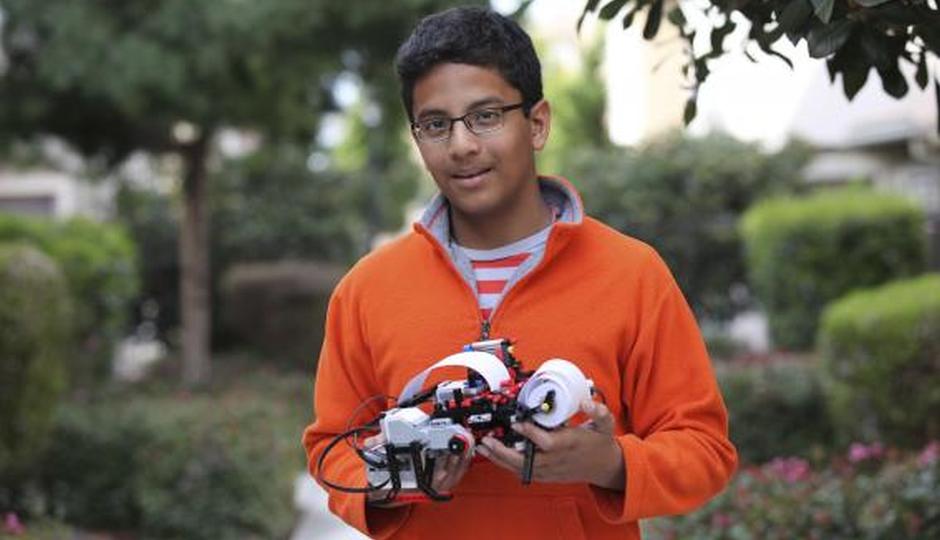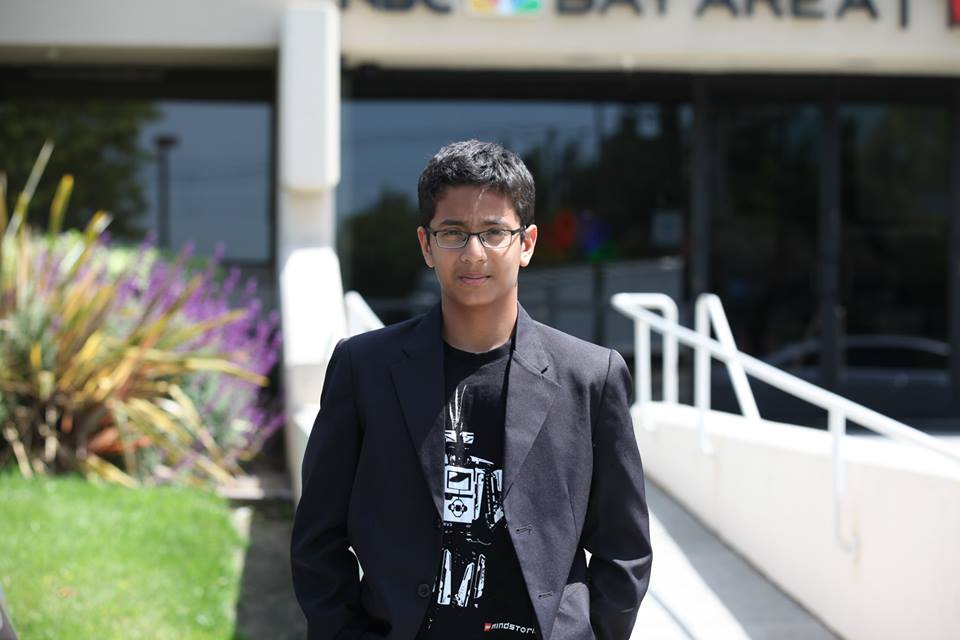This article was first published in ‘White Print’ – a braille magazine for the visually impaired, founded and published by Upasana Makati.
Amid the global dearth of low-cost technology available for the visually impaired, a 12-year-old boy marvel designed a Braille printer that can reduce the cost of manufacture from $2,000 to $350 with just a simple Lego set. Not only did Shubham Banerjee’s school science project lead him to make something that is creative, but it carries the potential to revolutionize Braille printing entirely.
Paparazzi flooded him, the media flocked to him for interviews, and Shubham Banerjee soon became a famous name. But for this boy wonder, the real joy came from the heart-warming responses he received from the visually impaired community. Here are a few excerpts from the interview conducted by Sharat Kumar.
Where It All Began
I was born in Hasselt, Belgium to Indian parents. We moved to San Jose, California when I was 3 years old and then to Santa Clara where I completed my elementary schooling at Don Callejon School. I am 12 years old now and am currently in the 7th grade at Champion School in San Jose.
We continue to reside in Santa Clara, California with my parents and younger sister Anoushka who is 8 years old. My mother is a teacher and father is an engineer in the technology field. I have relatives living in India apart from different parts of the world, including the USA.
The Power Of A Curious Mind
I definitely do have a curious mind, just as any normal kid of my age. Whenever I’ve wanted to buy something that is educational in nature, my parents have never said no. Over the dinner table or while relaxing we do have discussions about interesting news topics or science topics. We also ardently watch TED talks and my father regularly keeps forwarding interesting articles that he may have read on the Internet.
My mother takes a lot of care of my sister and me, which includes helping us with our studies and day-to-day work. My father is really busy with his work since he leads a team based in multiple geographical locations. I don’t know if there is anything special that we do as a family, but I’m lucky to be surrounded by technology geeks, living in Silicon Valley.
The Birth Of Braigo

I’ve been in love with LEGOS since I was 2 years old. Around December 2013, among the mail that came to our house, I noticed these posts that said, ‘Help the blind people with donations.’ I had no idea about Braille, so I asked my parents how blind people read and they said: “Google it!”
Upon further research, I discovered that typical Braille printers cost about $2,000 or even more, and I felt that was unnecessarily expensive for someone already at a disadvantage. I put my brain to work, and the first thing that came to mind was to create an alternative using my favourite toy. I took the LEGO model Mindstorms EV3 and devised a new kind of Braille printer that costs only $350.
The challenge with assistive technologies currently available is that they are either too expensive or difficult to obtain for normal people without government or non-profit sponsorships. According to WHO reports, there are an estimated 285 million visually impaired people worldwide and 90% of them live in developing countries. At this moment the cost of a Braille printer is more than $2000 for a basic version. Thus many millions of people across the world have limited access. If we could reduce the cost to below $500, then we’ve already reduced the cost by 75%.
Choosing Accessibility
To give access to easily assemble and build a Braille printer for the masses, the key lies in a Do-It-Yourself (D-I-Y) kit. The kit should be readily available at stores or procured online from reputable websites to make the process easy. Most printers operate in X (to move the print head) -Y (to push the paper) – Z (to print or not to print) coordinates. The printer has to be compact and self-explanatory.
Engineering as a discipline is the application of scientific, economic, social, and practical knowledge in order to design, build, maintain, and improve structures, machines, devices, systems, materials and processes. During this experiment, I relied on my love for LEGO and the readily available Mindstorms EV3 robotics kit to build a D-I-Y Braille printer and program the device to print in Braille. I consciously made sure that all parts should be from one kit accompanied by a few low cost readily available add-ons so that anyone can make such a printer.
After studying the Braille language, I understood that a visually impaired individual reads through a combination of 6 dots using his/her fingers. The idea was to make a printer that prints (by making holes in a paper) a mirror image of the letter and when we flip the page that combination of dots should translate into a letter in Braille. I used rapid prototyping concepts where I tried to build models and programmed them to see if I could achieve the desired results. I had to build and break 7 different models before settling on a final one that was able to print the six dots in a desired sequence according to Braille standards.
After which, I programmed the letters A-Z. I used a normal calculator paper to provide the proof of concept. I have validated my version 1.0 of BRAIGO. I’m also working on potential small updates in the software necessary to perfect the 2.0 version at the Santa Clara Valley Blind Centre based in San Jose and with Hoby Wedler at his laboratory in UC Davis.
I would say that the first prototype of the proof of concept has been successful and by providing the building instructions and software as open source will provide a low-cost alternative solution to the visually impaired community. I’ve achieved an 82% reduction in cost and have been overwhelmed by the encouraging feedback from both the sighted and the blind!
Bumps In The Road
It took me 3-3.5 weeks and I broke and re-assembled around 7 different types of models before settling on one and programming it. My dad was my guide whenever I got stuck. He works a lot, even from home after he comes back from office. He used to sit down with me on the kitchen table and while he continued with his conference calls and work, I worked on building the model.
For a couple of weeks, my days were very long. I used to start working on BRAIGO after I finished my homework and assignments and thus on some days I was awake until 2 am. But it was all worth it. There were times when it didn’t work and it was frustrating when a combination just wouldn’t program. The most difficult part was to create the head of the printer and a structure that works without breaking down.
The Response To Braigo

I am overwhelmed by the response I have received from the visually impaired community. Like in any social network, there were some people who were sceptical about it. But there were many more who encouraged and appreciated the effort. I think the news of the printer highlighted the plight of the visually impaired community. But when Hoby Wedler’s review on Braigo and the feedback from the Santa Clara Association of the Blind came out, I believe the doubts were put to rest
It feels good that I am getting recognition for my effort. I never imagined that it would become such big news. I started on the project to prove at my science fair that it’s not impossible to make a low-cost Braille printer. But I never thought that it would become such a success!
Expectations from me have rocketed up. Yes, they are definitely happy but at the same time, it’s now on my shoulders to keep up the momentum. My family has been very supportive.
The Road Ahead
The visually impaired community does hold a special place in my heart. I have made some amazing visually impaired friends. I feel they are much more optimistic about life and happier than sighted individuals. I am working on other projects at the moment but they aren’t ready to enough to be shared.
I wish I could suck out cancer cells somehow through a device. The chemical solutions are taking too long for this disease to be cured. Last year, my grandfather passed away within a couple of days of his first chemotherapy session.
Exploring New Avenues
I am learning to play the guitar. I play with my friends, compete in debating competitions and volunteer in non-profits and of course, fight with my sister!
Innovative minds like Shubham Banerjee’s are going to lead the race to a more inclusive, accessible future. We can’t wait to see what this whiz kid has in store for the world next!
Liked reading this? Then you might also like to read Shravan And Sanjay Kumaran – The Youngest Indian Brother-Duo Entrepreneurs Of GoDimensions
If there’s any story that needs to be told, we will tell it. Write to us at contact@knowyourstar.com with your story lead, or contact us on Facebook or Twitter.